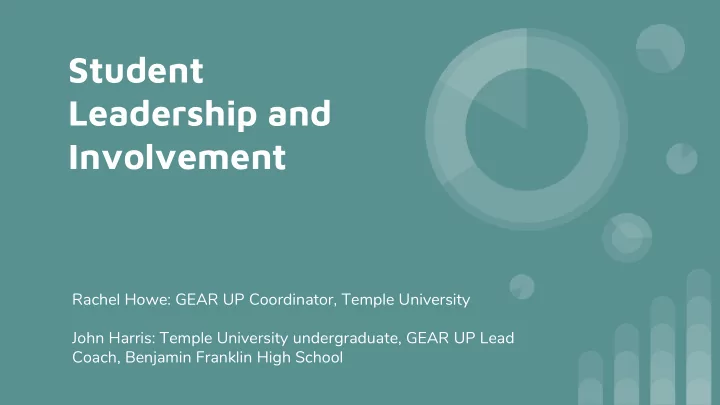

Student Leadership and Involvement Rachel Howe: GEAR UP Coordinator, Temple University John Harris: Temple University undergraduate, GEAR UP Lead Coach, Benjamin Franklin High School
Your Opinions and Feelings How do you feel when apprentice leaders or student leaders come to you with new ideas or suggestions? How do you feel when they identify problems or offer negative feedback? This might mean VISTAS, Americorps, youth fellows, college students, etc.
Gear Up Goals -Increase the academic performance and preparation for postsecondary education for GEAR UP students -Increase the rate of high school graduation and enrollment in postsecondary education for GEAR UP students - Increase students’ and their families’ knowledge of postsecondary education options, preparation, and finance
Recruit, train, place and support Temple students ● to assist in classrooms, after school programs, individual tutoring and mentoring, and postsecondary exploration Students make a once a week, one semester ○ commitment Students come from all majors ○ Engage parents and families in their students’ ● academic success and postsecondary planning Bring university resources to our partnership ● schools Structured with lead coaches, one lead coach per ● school
Current Stats Number of Schools 6 Number of Coaches 40-50 Number of Teachers 30 Number of Students 350 Served All numbers are per semester and approximate
GEAR UP as Service Learning What is Service Learning? Why We Fit This Category Theory of education which takes a Combine trainings and field experience ● ● pragmatic approach to learning by: Conduct regular reflection sessions for ● Bringing community and social coaches to share their thoughts and ○ projects to the forefront feelings Combines traditional teaching Each reflection provides us with a ○ ○ curriculums with real world different perspective on various application accomplishments and challenges Gives the participants a forum to Establish community connections through ○ ● reflect on their experiences over a projects and events course of time
Service Learning Best Practices We learn by doing. Specifically, doing service There cannot be simultaneous doing and learning without reflection Conducting service allows for: ● The creation of citizens Reflection grants: ○ ● The ability to become part of Understanding of things outside of ○ ○ something bigger than themselves one's own sphere Application of knowledge to Communication with others who ○ ○ something meaningful understand your experiences Consistency is key Removal of confirmation bias ○ ○ Success comes from relationship ○ building
Education is that whole system of “It is important that the students do not human training within and without the solely indulge in descriptions of their experiences, and it is important for school house walls, which molds and instructors to help guide students to continue to examine and question their develops men. experiences to link ideas back to the course through their facilitation of -W.E.B. DuBois discussions and reflection” (Barry, 2017). “At the heart of service learning is this very notion of “doing”, or putting into action the lessons presented in the classroom in a way that allows students to personally experience the material in a way that is often not possible within the confines of the classroom” (Parys 2015)
Evolution of the GEAR UP Structure 1. Structure outlined in grant: Coordinators oversee Coaches 2. Idea for Lead Coach at each school. a. Purpose: near peer connection b. Additional eyes and ears on the ground at schools 3. But what will they do???? a. Administrative tasks b. Be at school additional hours c. Provide feedback to Coordinators 4. But that wasn’t quite enough … a. Lead reflection sessions b. Develop activities c. Rally and engage other Coaches d. Special projects
The Lead Coach Perspective Lead Coaches report the importance of having a ● direct line of communication and a formal system for introducing new ideas and initiating change Lead Coaches have identified challenges and ● encouraged new ideas Lead Coaches report personal and professional ● growth. Three have gone on to internships with the Mayor’s Office. They feel a personal attachment to the program and have a stake in it’s growth. This attitude trickles down to regular Coaches ●
Lead Coach Directed Changes / Ideas Changes New Ideas Push for changes in classrooms ● stronger teacher relationships ○ Program Committee ● stronger student relationships ○ Speaker Series ○ More active during classtime ○ Participation in Parent Engagement ○ Spanish-only after school ○ Cultural Awareness Activities ○ Training and Professional Development ● Explore a Major Day ○ Topics College Corner ● Trauma Informed Tutoring ○ Resume writing and Naviance workshops ● School District 101 ○ Group Me ● Team Check-in Sessions ● Design Thinking Philly ●
Challenges: • Helping students understand bureaucracy • Helping students understand the school district • Keeping track of progress • Managing disappointment * Grit * Learning Opportunity * Teamwork * Management* Leadership Development *
Questions?
Closing Activity How does this link to your organization?
Citations Stallworth-Clark, Rosemarie. "Service-Learning for the Public Good: Educating for Social Justice." Journal of Education & Social Justice, vol. 5, no. 1, Spring 2017, pp. 81-93. Barry, Sarah M.1. "Methods of Reflective Practice in a Service-Learning Dance Pedagogy Course." Journal of Dance Education, vol. 17, no. 3, Jul-Sep 2017, pp. 124-130. Parys, Jodie. "Service Learning and LEAP: Increasing Respect for Diversity through Campus- Community Collaboration in Advanced Spanish Courses." Journal of Community Engagement & Scholarship, vol. 8, no. 1, Spring 2015, pp. 106-114. Friere WEB DUbois
Recommend
More recommend